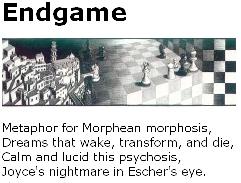Thursday, November 11, 2021
Operation Deep Freeze:
Friday, January 15, 2016
Enter Raven
Suggested by a passage at dazeddigital.com —
"Visser remembers the night everything changed
as if it was yesterday. It was February 3, 2010,
and the band had been booked to play a show
in Johannesburg."
Sunday, October 21, 2012
Logos
In memory of Leonard Shlain, author
of The Alphabet Versus the Goddess
Alphabet logo from the website
of a religious publishing company—
A logo for Charlize Theron, who played
a goddess figure in "Hancock"—
Click images for further details.
Friday, October 19, 2012
Torpedo… LOS!
"Hitchcock made movies with many actresses
who had the aloof, Nordic beauty he admired."
— Alessandra Stanley in today's NY Times
Aloof, Nordic…
Freeze Frame

Related material:
Wednesday, February 3, 2010
Holly Day
Thursday, July 2, 2009
Thursday July 2, 2009
Hieron Grammaton, Part III*
The Old Man and the Light
In memory of
Ernest Hemingway,
who died on this date
in 1961, a story
in three parts:
I — Eye of Raven
Fermata
II — Psyche and Symbol
Leonard Baskin, detail of
cover for Jung’s
Psyche and Symbol
III — Raven Steals the Light
Detail from the story
“Raven Steals the Light”
Midrash:
“To the earnestness of death belongs precisely that capacity for awakening, that resonance of a profound mockery which, detached from the thought of the eternal, is an empty and often brash jest, but together with the thought of the eternal is just what it should be….” —Kierkegaard
* For Hieron Grammaton, Parts I and II, see the five Log24 entries from 6:29 PM Tuesday, June 23, to 1:00 AM Sunday, June 28.
Wednesday, February 20, 2008
Wednesday February 20, 2008
|
M. V. Ramana on a famous quotation–
"Oppenheimer had learned Sanskrit at Berkeley so as to read the Gita in the original; he always kept a worn pink copy on the bookshelf closest to his desk. It is therefore likely that he may have actually thought of the original, Sanskrit, verse rather than the English translation. The closest that fits this meaning is in the 32nd verse from the 11th chapter of the Gita.
This literally means: I am kAla, the great destroyer of Worlds. What is intriguing about this verse, then, is the interpretation of kAla by Jungk and others to mean death. While death is technically one of the meanings of kAla, a more common one is time." "KAla" (in the Harvard-Kyoto transliteration scheme) is more familiar to the West in the related form of Kali, a goddess sometimes depicted as a dancing girl; Kali is related to kAla, time, according to one website, as "the force which governs and stops time." See also the novel The Fermata, by Nicholson Baker. The fact that Oppenheimer thought of Chapter 11, verse 32, of the Gita may, as a mnemonic device, be associated with the use of the number 1132 in Finnegans Wake.
|
The custom-made asterisk
above may be regarded
as a version of
the "Spider" symbol
of Fritz Leiber.
… Todo lo sé por el lucero puro
que brilla en la diadema de la Muerte.
Related material:
The previous five entries
and the entries of
this date three years ago.
Time of this entry:
Tuesday, January 4, 2005
Tuesday January 4, 2005
“Mr. Denker was of the romantic school
of chess – always looking to attack.”

Related material:
From Endgame:

Black the knight upon that ocean,
Bright the sun upon the king.
Dark the queen that stands beside him,
White his castle, threatening.
In the shadows’ see a bishop
Guards his queen of love and hate.
Another move, the game will be up;
Take the queen, her knight will mate.
The knight said “Move, be done. It’s over.”
“Love and resign,” the bishop cried.
“When it’s done you’ll stand forever
By the darkest beauty’s side.”
From Log24.net, Feb. 18, 2003:

Kali, a goddess sometimes depicted
as a dancing girl; Kali is related to kAla,
time, according to one website, as
“the force which governs and stops time.”
See also the novel The Fermata,
by Nicholson Baker.

From an entry of Sunday, Jan. 2,
the day Denker died:
“Time had been canceled.”
— Stephen King, The Shining
From Truth and Style, a tribute
to the late Amy Spindler, style editor
of the New York Times Magazine:
“I don’t believe in truth. I believe in style.”
— Hugh Grant in Vogue magazine, July 1995
From a related page,
The Crimson Passion:
“He takes us to the central activity
of mathematics—which is imagining….”
— Harvard Magazine on
Harvard mathematician
and author Barry Mazur.
For related material on Mazur, see
“The teenagers aren’t all bad.
I love ’em if nobody else does.
There ain’t nothing wrong
with young people.
Jus’ quit lyin’ to ’em.”
Tuesday, February 18, 2003
Monday, February 17, 2003
Monday February 17, 2003
Center of Time
|
Am I…. your fantasy girl Machine ballerina? |
From the |
“The old man of ‘Sailing to Byzantium’ imagined the city’s power as being able to ‘gather’ him into ‘the artifice of eternity’— presumably into ‘monuments of unageing intellect,’ immortal and changeless structures representative of or embodying all knowledge, linked like a perfect machine at the center of time.”
— Karl Parker, Yeats’ Two Byzantiums
“I wrote Fermata listening to Suzanne Vega, particularly her album ‘99.9° F.’ It affected my mood in just the right way. I found a kind of maniacal intensity in her music that helped me as I typed. So if Fermata is attacked, maybe I can say i’m not responsible because I was under the spell of Suzanne Vega.”
— Nicholson Baker, interview
For some real monuments of unageing intellect, see “Geometrie” in the weblog of Andrea for February 10, 2003.
Saturday, February 15, 2003
Saturday February 15, 2003
The Recruit
From an obituary of Walt W. Rostow, advisor to presidents and Vietnam hardliner:
“During World War II, he served in the Office of Strategic Services, the predecessor agency to the Central Intelligence Agency.”
Rostow died on Thursday, February 13, 2003, the anniversary of the 1945 firebombing of Dresden.
Like von Neumann, Rostow exemplified the use of intellectuals by the state. From a memoir by Rostow:
“…in mid-1941…. American military intelligence… was grossly inadequate….
…military leaders… learned that they needed intellectuals….
Thus the link was forged that yielded the CIA, RAND, the AEC, and all the other institutionalized links between intellectual life and national security that persist down to the present.”
— Walt W. Rostow, “Recollections of the Bombing,”
University of Texas web page
“Look at that caveman go!”
— Remark in my entry of February 13, 2003
“So it goes.”
— Remark of Kurt Vonnegut in Slaughterhouse-Five
See also
Tralfamadorian Structure
in Slaughterhouse-Five,
which includes the following passage:
“…the nonlinear characterization of Billy Pilgrim emphasizes that he is not simply an established identity who undergoes a series of changes but all the different things he is at different times.”
 |
 |
For a more recent nonlinear characterization, see the poem “Fermata” by Andrew Zawacki in The New Yorker magazine, issue dated Feb. 17 and 24, 2003, pp. 160-161. Zawacki is thirty years younger than I, but we share the same small home town.









